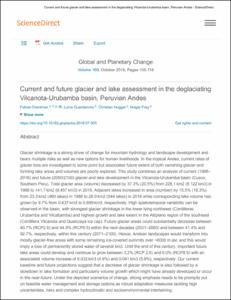Mostrar el registro sencillo del ítem
Current and future glacier and lake assessment in the deglaciating Vilcanota - Urubamba basin, Peruvian Andes
| dc.contributor.author | Drenkhan, Fabian | |
| dc.contributor.author | Guardamino, Lucía | |
| dc.contributor.author | Huggel, Christian | |
| dc.contributor.author | Frey, Holger | |
| dc.date.accessioned | 2018-12-18T20:12:17Z | |
| dc.date.available | 2018-12-18T20:12:17Z | |
| dc.date.issued | 2018-10 | |
| dc.identifier.citation | Drenkhan,F., Guardamino, L., Huggel, C. et al. (2018) Current and future glacier and lake assessment in the deglaciating Vilcanota - Urubamba basin, Peruvian Andes. Global and Planetary Change, 169, 105-118. doi: https://doi.org/10.1016/j.gloplacha.2018.07.005 | es_PE |
| dc.identifier.issn | ISSN: 0921-8181, ESSN: 1872-6364 | es_PE |
| dc.identifier.uri | https://hdl.handle.net/20.500.12543/3148 | |
| dc.description | Original abstract: Glacier shrinkage is a strong driver of change for mountain hydrology and landscape development and bears multiple risks as well as new options for human livelihoods. In the tropical Andes, current rates of glacier loss are investigated to some point but associated future extent of both vanishing glacier and forming lake areas and volumes are poorly explored. This study combines an analysis of current (1988–2016) and future (2050/2100) glacier and lake development in the Vilcanota-Urubamba basin (Cusco, Southern Peru). Total glacier area (volume) decreased by 37.3% (20.5%) from 226.1¿km2 (8.122¿km3) in 1988 to 141.7¿km2 (6.457¿km3) in 2016. Adjacent lakes increased in area (number) by 15.5% (18.3%) from 23.3¿km2 (460 lakes) in 1988 to 26.9¿km2 (544 lakes) in 2016 while corresponding lake volume has grown by 9.7% from 0.637¿km3 to 0.699¿km3, respectively. High spatiotemporal variability can be observed in the basin, with strongest glacier shrinkage in the lower lying northwest (Cordilleras Urubamba and Vilcabamba) and highest growth and lake extent in the Altiplano region of the southeast (Cordillera Vilcanota and Quelccaya ice cap). Future glacier areas could substantially decrease between 40.7% (RCP2.6) and 44.9% (RCP8.5) within the next decades (2031–2060) and between 41.4% and 92.7%, respectively, within this century (2071–2100). Hence, Andean landscapes would transform into mostly glacier-free areas with some remaining ice-covered summits over ~6000¿m asl. and this would imply a loss of permanently stored water of several km3. Until the end of this century, important future lake areas could develop and continue to grow between 3.2% (RCP 2.6) and 6.0% (RCP8.5) with an associated volume increase of 0.032¿km3 (4.6%) and 0.041¿km3 (5.9%), respectively. Our current baseline and future projections suggest that a decrease of glacier shrinkage is also followed by a slowdown in lake formation and particularly volume growth which might have already developed or occur in the near-future. Under the depicted scenarios of change, strong emphasis needs to be promptly put on feasible water management and storage options as robust adaptation measures tackling high uncertainties, risks and complex hydroclimatic and socioenvironmental intertwining. | es_PE |
| dc.description | Artículo en período de embargo | es_PE |
| dc.description.abstract | Menciona que la contracción del glaciar es un fuerte impulsor del cambio para la hidrología de las montañas y el desarrollo del paisaje y que acarrea riesgos y oportunidades para los medios de vida humanos. En los Andes tropicales, las tasas actuales de pérdida de glaciares se investigan hasta cierto punto, sin embargo, la extensión futura del glaciar que se desvanece y la formación de áreas de lagos y los volúmenes están poco exploradas. Este estudio combina un análisis sobre desarrollo glaciar y lacustre actual (1988–2016) y futuro (2050/2100) en la cuenca Vilcanota-Urubamba (Cusco, sur de Perú). | es_PE |
| dc.format | application/pdf | es_PE |
| dc.language.iso | eng | es_PE |
| dc.publisher | Elsevier | es_PE |
| dc.relation.ispartofseries | Global and Planetary Change, October 2018, Volume 217, pp 105-118 | es_PE |
| dc.relation.uri | https://doi.org/10.1016/j.gloplacha.2018.07.005 | |
| dc.rights | info:eu-repo/semantics/closedAccess | es_PE |
| dc.rights | Attribution-NonCommercial-NoDerivatives 4.0 International | * |
| dc.rights.uri | https://creativecommons.org/licenses/by-nc-nd/4.0/ | * |
| dc.source | Autoridad Nacional del Agua | es_PE |
| dc.source | Repositorio institucional - ANA | es_PE |
| dc.subject | Comportamiento de eventos extremos de origen glaciar y climático | es_PE |
| dc.subject | Gestión de riesgos de desastres en recursos hídricos | es_PE |
| dc.subject | Monitoreo de lagunas y glaciares | es_PE |
| dc.title | Current and future glacier and lake assessment in the deglaciating Vilcanota - Urubamba basin, Peruvian Andes | es_PE |
| dc.type | info:eu-repo/semantics/article | es_PE |
| dc.identifier.doi | https://doi.org/10.1016/j.gloplacha.2018.07.005 | es_PE |
| dc.coverage.basin | Cuenca Urubamba |








